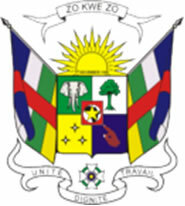The Central African Republic is a nation on the African continent. Its territory is landlocked and borders Sudan (to the east), Democratic Republic of Congo (to the south), Congo (to the southwest), Cameroon (to the west) and Chad (to the north). The country is covered by savannas and is home to wildlife reserves.
Like other African nations, the region that currently corresponds to the Central African Republic had its natural resources exploited by Europeans, mainly by the French. The settlers enslaved the local population for agricultural work, mainly in the cultivation of coffee and cotton, in addition to ivory extraction (obtained through the canine teeth of elephants, walruses and hippos) and Diamond. National independence was only won in 1960.
The lack of infrastructure reflects on the weak economy of the country, which is one of the poorest in the world. The main activity responsible for raising financial resources is agriculture, which is based on the cultivation of coffee, cotton, cassava and yam. The industrial sector is underdeveloped, operating in the textile, food, beverage, tobacco, furniture and paper segments.
According to data released in 2010 by the United Nations (UN), the Central African Republic has Human Development Index (HDI) of 0.315, occupying the 159th place in the world ranking, which is formed by 169 countries. Among the various socioeconomic problems are: most inhabitants live below the poverty line; malnutrition affects 43% of the population; the infant mortality rate is one of the highest on the planet: 103 for every thousand live births; life expectancy is just 44 years and the illiteracy rate is 52%.
Do not stop now... There's more after the advertising ;)

Coat of Arms of the Central African Republic
Data from the Central African Republic:
Territorial extension: 622,984 km².
Location: Africa.
Capital: Bangui.
Climate: Equatorial (south), and tropical (north and central portion).
Government: Republic with mixed form of government.
Administrative division: 16 prefectures and one commune.
Languages: French (official), Sango.
Religions: Christianity 65.1% (20.2% Catholics, 16.8% Protestants, no affiliation 15.8%, others 12.3%), Islam 14.5%, traditional beliefs 19.5%, no religion 0 .7%, Bahaism 0.2%.
Population: 4,422,397 inhabitants. (Men: 2,172,646; Women: 2,249,751).
Composition: Baias 34%, bands 27%, mandiás 21%, you will be 10%, umbundus 4%, umbacas 3%, cares 1%.
Demographic density: 7 inhab/km².
Average annual population growth rate: 1.8%.
Population residing in urban areas: 38.72%.
Population residing in rural areas: 61.28%.
Undernourished population: 43%.
Life expectancy at birth: 44 years.
Households with access to drinking water: 66%.
Households with access to the health network: 31%.
Human Development Index (HDI): 0.315 (low).
Currency: CFA Franc.
Gross Domestic Product (GDP): $2 billion.
GDP per capita: $394.
External relations: World Bank, IMF, WTO, UN, AU.
By Wagner de Cerqueira and Francisco
Graduated in Geography
Brazil School Team
countries - geography - Brazil School
